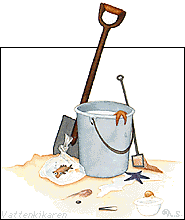|
|
|
Which organisms?
Many hardy organisms can be found along the waters edge and in rock
pools. In rock pools variations in salinity and temperature can vary
greatly. Creatures found living under such conditions can be very
suitable as aquarium inhabitants.
Collecting organisms can be conducted in several different
ways. With a net, shrimps, small fish and other quick moving creatures
that move amongst the seaweed can easily be caught. Other organisms
such as gribbles, mud shrimps, periwinkles and worms can easily be
found by turning over rocks.
Some of the creatures that are easily captured are predators.
When releasing such organisms into your aquarium there is a risk that
they eat up all your other animals. Examples of such animals are crabs,
hermit
crabs , starfish,
ragworms
and most fish. Many of them are very lively and interesting to study
in an aquarium, but you have to know that combining certain creatures
can be difficult.
Food
Many predators also eat carrion. This means that they eat dead meat,
i.e. pieces of mussels. This is practical because the mussel is very
common in Swedish waters and are easily bought in foodstores, but
remember to be moderate with the amount of food you give them.
Many small creatures gladly eat the small crustacean
Artemia salina. Eggs and a cultivation description are usually
found in many aquarium shops.
Filtering organisms can be more difficult to keep in an aquarium
because they eat algae and other small organisms that hover around
in the water. It is possible to feed them with bakers yeast, dried
spinach and flaked fish food that is crumbled and mixed with the sea
water. The problem is that a large part of the food falls to the bottom
and spoils the water. It is also possible to suck up the food with
a long pipett and then discharge it close to a filtering creature,
but this has to be done very carefully as the animals are often very
sensitive for disturbances.
Many small creatures will eat pulverized spinach that
is mixed withsea water. You can take a piece of frozen spinach, the
equivalent of a table spoon and mix it with 1-2 dl of sea water that
has been finely filtered and mix it in a blender. Thereafter it can
be stored in a refrigerator for up to a couple of weeks. With the
help of a pipett you can feed your organisms one drop at a time.
It is not always so easy knowing what the different creatures
eat. In the facts
section of Aquascope you can find more information.
|

